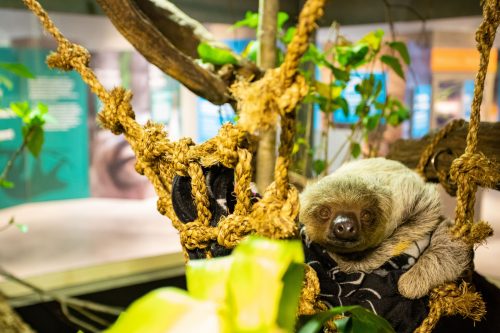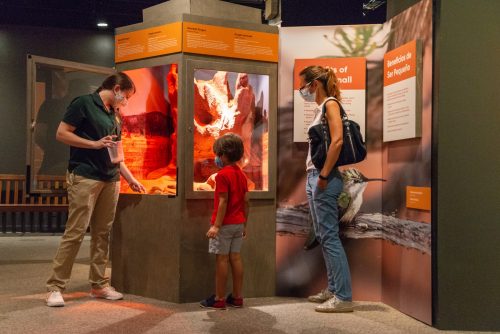GAINESVILLE, Fla. — Florida Museum of Natural History visitors can gear up for close encounters of the slow kind in the new “Survival of the Slowest” exhibit, opening Jan. 23, 2021.

Guests will get an up-close look at a live sloth, tortoise, iguana and other creatures to learn about the unique adaptations some animals developed to survive, despite being slow, small or weak.
“Most people hear the phrase ‘survival of the fittest’ and assume it means the strongest will survive, but that’s not always the case. What about when being slow or small is an advantage in an environment?” said Julie Waters, Florida Museum exhibit coordinator. “This exhibit will challenge visitors to think about what it truly takes to survive.”
The exhibit features 16 animal species, showcasing a variety of wildlife. A keeper will be present to answer guests’ questions and ensure the animals’ wellbeing.
“The exhibit has fantastic information in it, but the animals are the real stars of the show,” Waters said. “Having an on-site keeper available to teach us more about these animals is an amazing opportunity that visitors will love.”
Featured animals are as follows:
- Linnean two-toed sloth
- pygmy hedgehog
- red-footed tortoise
- fox snake
- green iguana
- veiled chameleon
- box turtle
- giant Madagascar day gecko
- grey rat snake
- Asian water dragon
- Madagascar giant hognose
- blue-tongued skink
- horned frog
- bearded dragon
- green basilisk
- pine snake

Graphics and educational panels help illustrate the variety of characteristics animals have developed to survive, such as warm and cold blood temperatures and difference in size, speed and energy use.
Admission to “Survival of the Slowest” is $10 for adults; $9 for Florida residents, seniors and non-University of Florida college students; $7 for ages 3-17 and free to museum members and UF students with a valid Gator 1 Card. Complete admission pricing is available online at www.floridamuseum.ufl.edu/visit/plan. The Florida Museum will display the exhibit through Sept. 12, 2021.
“The Museum’s exhibit schedule changed due to the pandemic, and we had to delay the opening of this exhibit,” Waters said. “I’m very excited that it’s finally here and we can share this remarkable experience with our visitors.”
The Florida Museum requires masks at all times and has a one-way path to ensure social distancing.
This exhibit was produced by Little Ray’s Nature Centres in partnership with the Canadian Museum of Nature and sponsored in part by Visit Gainesville/Alachua County, University of Florida Student Government and the Florida Division of Cultural Affairs.
For more information, visit www.floridamuseum.ufl.edu/exhibits/survival or call 352-846-2000.
-30-
Writer: Nikhil Srinivasan, 352-273-2034, nsrinivasan@floridamuseum.ufl.edu
Source: Julie Waters, jmwaters@floridamuseum.ufl.edu
Media contact: Kaitlin Gardiner, kgardiner@floridamuseum.ufl.edu